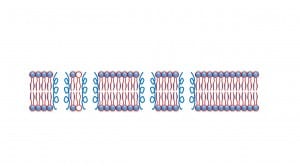New publication on “molecular fingerprints” for antimicrobial peptides
The Camesano lab recently published a paper in Biophysical Chemistry that seeks to explain how different types of antimicrobial peptides interact with cell membranes. Antimicrobial peptides can represent and exciting new class of antibacterial molecules. Because they act in a different way than traditional antibiotics, it is very unlikely that bacteria will be able to develop a resistance to these peptides. This work,led by recent PhD recipient Kathleen Wang, and in partnership with the Natick Soldier Research, Development & Engineering Center (Natick Labs) follows the mechanism of action of 4 common antimicrobial peptides on a bacterial membrane. The ability of the peptide to kill bacteria depends on the physical and structural properties of the peptides. This work can help us design newer and more effective antimicrobial therapies, which will not promote antibiotic resistance.

